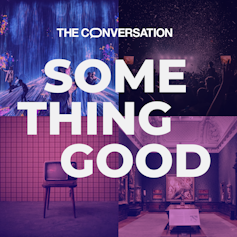Artists, poets, musicians and physical performers all know the power of improvisation – spontaneous expression, responsive play with others, experimentation, vulnerability, even chaos. All this can generate potent new art forms and dramatically energise the creative process, as anyone who has enjoyed a good improv show at the Edinburgh Fringe – beginning next week – will know.
But none of these elements is the natural habitat of academic research. I am an art historian specialising in the 20th century’s most radical avant-garde movement: Dada, which began in Zurich in 1916. The city drew exiles, dissenters, displaced artists, writers and performers from across Europe to the relative peace and freedom of neutral Switzerland during the first world war.
In a shabby alley in Zurich’s old town, German poet Hugo Ball founded the Cabaret Voltaire. This legendary nightclub’s artists and performers included Emmy Hennings, Tristan Tzara and Hans Arp, with Sophie Taeuber Arp joining them a little later. Over its few months of existence, it quickly became a site of bold multilingual experimentation, protest, play and subversion.

Looking for something good? Cut through the noise with a carefully curated selection of the latest releases, live events and exhibitions, straight to your inbox every fortnight, on Fridays. Sign up here.
Performances were unpredictable and impromptu. The latest art hung on the walls. There were songs, poems, dances and sketches – some were popular cabaret numbers, but others were completely new.
Melody gave way to noise. Dance gave way to strange new physical movements. Sense gave way to nonsense. Decorum gave way to chaos, and anger at the war erupted. What emerged in Zurich as “Dada” profoundly challenged what it meant to make art, poetry and music in the face of a society tearing itself apart.
The Dadaists were consummate improvisers. They embraced chance, montage and incongruity. In their collages, sound poems, manifestos and public demonstrations, they favoured surprise, rupture and shock. They did not create for the museum, the archive or the concert hall, and frequently derided the professors who sought to study them.
A 21st-century dialogue with Dada
As one such academic, I wanted to explore the role of improvisation at the Cabaret Voltaire. Doing so has shaken up my way of thinking about Dada – all thanks to a loose, open and diverse Glasgow-based group of sonic improvisers called GIOdynamics.
The group is led by musician and dramatist Jer Reid, my invaluable collaborator. GIOdynamics’ regular improvisation evenings in Glasgow reminded me of aspects of Dada performance – and so the idea for our collaborative experiment, DADAdynamics, emerged.
Through improvisation in sound and movement, we wanted to discover more about the Cabaret Voltaire and its resonances today. Guided both by Reid’s bold creative vision and what emerged from the performers’ improvisation, we explored some of the fragmentary remains of Dada – a phenomenon that “hit the spectator like a bullet”, as German cultural critic Walter Benjamin memorably described it.
Our plan was not to attempt a reconstruction. Rather, holding loosely to Dada’s historical shards, we engaged in something more like a creative dialogue with Dada for today. It all came together in a sold-out public performance earlier this year called DADAdynamics: An Evening at the Cabaret Voltaire 1916/2024.
We had no idea how our audience, packed into a hot Glasgow bar venue, would react. But from the start, there was what the Dadaists experienced too: laughter, astonishment, sombre reflection on war – and a touch of mayhem. The experience felt as unpredictable, as risky and as spirited as I imagine nights at the Cabaret Voltaire were.
Reid and choreographer Aby Watson led the group in physically exploring the improvised “masked dances” that were a regular feature of the early performances in Zurich. Following the Dadaist Marcel Janco, we made our own masks out of found materials, with bizarre and striking results. Gloves became beards, keys became eyelids, and pegs became noses. There were resonances with the wounds and prosthetics of that first world war era, and with the waste and excess of our own age.
I recited Dada texts on stage, feeling the force of old words of anti-war protest, none of it lost in translation. Armin Sturm, from Germany, performed sound poems by Hugo Ball, dressed to extraordinary effect in a cylindrical cardboard version of the Cubist costume which Ball wore and described as a “magical bishop” with a “shaman’s hat”.
As performers, we all discovered more about what the Dadaists were doing. I learned, especially, about the creative importance of empathy, trust in the process, and resisting the idea of making everything seamless.
Our most ambitious undertaking was the rarely performed seven-act, purely sonic Nativity Play: Bruitistic, also by Ball. Bruitism, from the French for noise, was a crucial concept in wartime avant-garde circles. It expanded music-making to include all the noises of modern life, violent or mundane: bells, whistles, chains, pots and pans, whips, bangs, propellers, hammers, animal sounds, human cries and more.
Reid asked what the Dadaists might have done had they had access to basic synthesisers. And so our nativity play took the sounds that Ball’s score listed, looping and warping some of them to remarkable effect.
We were all struck by the intense emotional range of the piece. There was childlike joy and absurdity, violence in the form of a propellor-powered angel, and a final anguished lament.
The play ends with Mary’s prophetic foresight of the crucifixion of her baby son. His bloodshed, and the wails of the human and non-human alike, was and is a reminder of the brutal deaths of legions of young people in 1916, across the battlefields of Europe and beyond – and across our increasingly fractured world now.![]()
Deborah Lewer, Senior Lecturer in History of Art, University of Glasgow
This article is republished from The Conversation under a Creative Commons license. Read the original article.
Comments